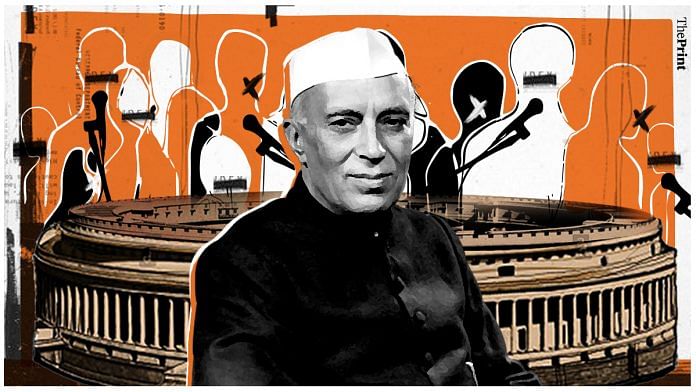Thank you dear subscribers, we are overwhelmed with your response.
Your Turn is a unique section from ThePrint featuring points of view from its subscribers. If you are a subscriber, have a point of view, please send it to us. If not, do subscribe here: https://theprint.in/subscribe/
India’s political imagination today is torn between two extremes—shattered coalitions that failed to govern and a concentrated command that refuses to be questioned. But beneath this ongoing tug-of-war lies a truth we seldom articulate: that the architecture of modern India was built by one man, and nearly every political formation since has either tried to inherit it, destroy it, or rewrite it.
This is not a sentimental plea for nostalgia. It is a structural reading of Indian political history—one that places Jawaharlal Nehru not just as India’s first Prime Minister, but as the foundational coder of the Indian state. And once you accept that frame, what follows becomes clear: much of Indian politics since 1964 has been a series of anti-Congress reactions—first fragmented and ideological, now consolidated and authoritarian.
The Architect and the Reaction
Between 1947 and 1964, Nehru established not just a government, but an intellectual architecture—rooted in secularism, state-led development, democratic institutions, and international non-alignment. His model was flawed, yes. But it was coherent. It had direction, and it carried moral seriousness.
What came after Nehru’s death was not a smooth transition of ideology, but a vacuum. Indira Gandhi briefly held the centre with brute force. But her 1975 Emergency exposed a reality: without Nehru, Congress had no intellectual anchor left. What remained was a growing tide of opposition—not from one front, but two.
The Left-Wing Anti-Congress: Fragmentation with a Conscience
Between 1977 and the 1990s, Indian politics saw the rise of social justice coalitions—Janata Dal variants, Mandal-driven parties, regional caste-based movements. From Lalu Prasad Yadav to Mulayam Singh Yadav, Nitish Kumar to Deve Gowda, a host of leaders emerged from the embers of anti-Emergency resistance.
They had moral legitimacy, deep grassroots, and a promise of social equity. But they lacked one thing: unity. Every one of these movements defined themselves by what they opposed, not what they could build. Coalitions rose and fell. Governance suffered. Institutions stalled. The dream of a welfare state without central coordination was noble—but flawed.
The Right-Wing Anti-Congress: Consolidation with a Mission
While the left fragmented, the right studied, organized, and waited. From the ashes of the Jan Sangh and the anger around Babri Masjid, the BJP emerged—not just as a party, but as a disciplined ideological force.
Vajpayee played statesman. Modi brought cultural command. The right-wing succeeded where the left failed—not because its moral compass was stronger, but because its messaging was simpler, its machinery more coherent, and its leadership undivided.
Today, the BJP stands as the only post-Congress formation that has successfully replaced the centralised aura that Nehru once wielded. But it has done so by attacking the very institutions and pluralism that Nehru painstakingly nurtured.
The Prime Ministerial Map: Reflections of a Broken Mirror
If we were to classify India’s Prime Ministers post-Nehru, a pattern emerges:
- The Architects: Nehru built. Indira tried to imitate through control.
- The Fragmented Dissenters: VP Singh, Deve Gowda, Gujral, and others—brief, moral, but politically brittle.
- The Adaptors: Vajpayee—ideologically right, institutionally cautious.
- The Puppets: Manmohan Singh—intellectually capable, politically constrained.
- The Rewriter: Modi—determined to erase, not evolve, India’s first chapter.
This is not to judge each leader harshly, but to suggest that none since Nehru have managed to offer a full ideological and institutional replacement. Some tried to share power but lacked direction. Others seized power but broke systems to keep it.
What India Needs Now: A Thoughtful Centre
India today is not ideologically polarised—it is ideologically exhausted. The Congress is a memory. The Left is scattered. The Right is dominant—but increasingly exclusionary. And yet, the hunger among citizens is not for slogans, but for governance, dignity, and delivery.
What India lacks is a serious, centrist political imagination—one that is not defined by its opposition to Nehru or Modi, but by its ability to govern in a post-polarised world.
To build this, we must first understand our political DNA. We must study not just the leaders who won elections, but the structures they either built, borrowed, or broke. And we must ask: is it possible to create a new political formation that neither fragments nor dominates—but delivers with dignity?
The answer to that question may well define the next chapter of Indian democracy.
Author’s Note: The views expressed are based on ongoing political-historical research. The author is part of Vastuta, an emerging centrist policy platform exploring governance futures for India.
These pieces are being published as they have been received – they have not been edited/fact-checked by ThePrint.


